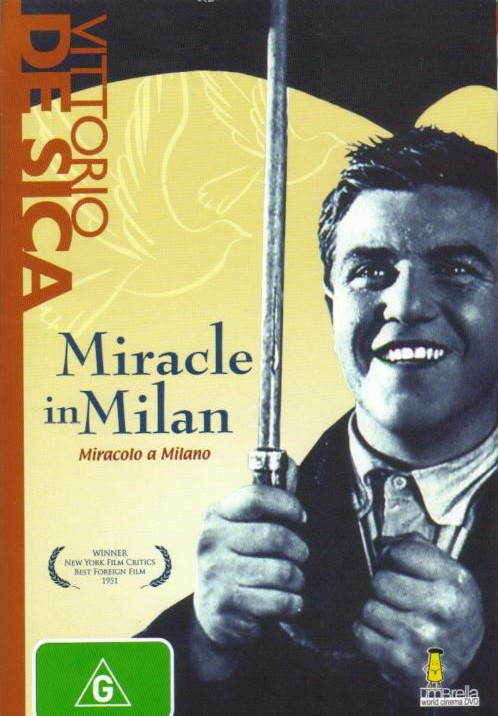Miracle in Milan (Miracolo a Milano) (1951) |
|
Miracle in Milan (Miracolo a Milano) (1951) |
|


|
| BUY IT |
| General | Extras | ||
| Category | Drama |
Main Menu Audio & Animation Featurette-Documentary On The Premiere Interviews-Crew-Manual De Sica And Brunella Bovo Gallery-Stills Theatrical Trailer Trailer-I Vitelloni |
|
| Rating |

|
||
| Year Of Production | 1951 | ||
| Running Time | 93 | ||
| RSDL / Flipper | Dual Layered | Cast & Crew | |
| Start Up | Menu | ||
| Region Coding | 1,2,3,4,5,6 | Directed By | Vittorio De Sica |
|
Studio
Distributor |
 Umbrella Entertainment |
Starring |
Emma Gramatica Francesco Golisano Paolo Stoppa Guglielmo Barnabò Brunella Bovo Anna Carena Alba Arnova Flora Cambi Virgilio Riento Arturo Bragaglia Erminio Spalla Riccardo Bertazzolo Checco Rissone |
| Case | Amaray-Transparent | ||
| RPI | $29.95 | Music | Alessandro Cicognini |
| Video | Audio | ||
| Pan & Scan/Full Frame | Full Frame | Italian Dolby Digital 2.0 mono (224Kb/s) | |
| Widescreen Aspect Ratio | None | ||
| 16x9 Enhancement | No | ||
| Video Format | 576i (PAL) | ||
| Original Aspect Ratio | 1.37:1 | Miscellaneous | |
| Jacket Pictures | No | ||
| Subtitles | English | Smoking | No |
| Annoying Product Placement | No | ||
| Action In or After Credits | No | ||
Miracle in Milan, released in 1951, is bookended by director Vittorio de Sica's two neo-realist masterpieces The Bicycle Thief and Umberto D. In stark contrast to those movies, Miracle in Milan is an enjoyable fable set against the neo-realist world rather than an example of slice-of-life cinema itself.
Like those films mentioned, Miracle in Milan was a collaboration between de Sica and writer Cesare Zavattini.
The story begins, as do all good fables, with the words "Once upon a time". Young Toto (Francesco Golisano) is discovered in a cabbage patch by an elderly woman. She raises and tutors him. At her death he is put into an orphanage. He leaves the orphanage with a positive attitude towards life and an irrepressible smile.
After an incident when his bag is stolen he comes into contact with a member of Milan's poor who offers him a bed for the night in a tent land on the outskirts of town. The presence of Toto energises the homeless community and when the tents are destroyed in a wind storm, the residents are galvanised into building a small shanty town. Against this down-and-out backdrop de Sica throws some greedy landowners and the film becomes something of a battle between the rich and the poor. Not only has Toto got a magical soul, but through divine intervention he receives the power to grant real wishes, a focus of the last third of the movie. The power is a great gift but it comes with its own problems.
This is not simply a film about the trauma of poverty in post-war Italy. Although principally a comedy there are times where, almost surreptitiously, it becomes a stinging indictment on behaviour of the big business after the war. The poor go about their little lives with a modicum of dignity and a honesty, but once oil is discovered in the shanty town big business sets out to protect its own interest at the expense of this well-ordered society.
All this is couched in a fantastical story with a continuous undercurrent of comedy. These poor do not bemoan their fate or threaten to rise up against the rich; as they say in their song, the rousing theme of the movie:
Miracle in Milan is not a masterpiece; but it is a fun and enjoyable film (something that is hard to say about most neo-realist cinema!) with great performances from Francesco Golisaino - who sadly died in a car crash in 1958 - and others, including Brunella Bruni as Toto's love interest. Although de Sica had a strong point to make, the film uses humour to draw back from its darkest moments. Ultimately, he emphasises the strength and spirit of the poor.
In an interview included as an extra, the director's son notes that the original title of the movie was "The Poor Are a Disturbance," but was changed to make the film more of a celebration that an indictment. De Sica also dispels the myth that neo-realist films were shot quickly on location. Apparently, a great deal of time was taken with rehersals for the many non-actors who made up the cast, including a core of apparently hard drinking tramps who had to be woken for the morning shoot with buckets of water! The fact that the film has such a large cast of non-actors makes it less successful than other de Sica neo-realist films, as the overall standard of performance is uneven. Perhaps that is due to the demands of comedy rather than the particular group of people chosen.
Like Forrest Gump, Toto is exposed to some of the worst in human nature but comes through with a smile.
Miracle in Milan was the winner of the grand prix at Cannes in 1951 as well as the 1951 New York Film Critics' Award. Unlike de Sica's two previous films, it was not rewarded an Oscar and represents an unusual blend of the fantastical with neo-realist cinema. Miracle in Milan is enjoyable in itself and is indispensible for any fan of early Italian cinema or the works of de Sica.
Miracle in Milan is presented on DVD in a 1.33:1 transfer which is close to its original aspect ratio. Like The Bicycle Thief, this film has been through the restoration process. The process has really been one of nicely putting the film together, rather than concentrating on the complete restoration of the image. After a very shaky start with a production logo that's about to fall apart, the film settles into a comfortable state of acceptable image quality. The visual quality of the film varies, with some scenes exhibiting damage and artefacts aplenty while others relatively clear. The level of grain is not excessive. All in all the image quality is satisfactory.
According to the director's son, there was some computer improvement of some scenes, particularly the special effects. Those effects still look cheesy even by the Hollywood standards of the day, but that does not detract from the spirit of the film.
There is an acceptable level of grain in the movie and there are also instances where the stock jumps between different quality image quite remarkably. For example at 28:50, the film cuts between Toto and his girl and the visual quality between the two shots is entirely different. Once again this is acceptable given the nature of the source material but such moments are noticeable.
The overall image is fairly soft.
All in all, this is probably the best that Miracle in Milan will look until someone decides to conduct a frame by frame restoration.
There are removable sub-titles which are clear and easy to read.
| Sharpness | |
| Shadow Detail | |
| Colour | |
| Grain/Pixelization | |
| Film-To-Video Artefacts | |
| Film Artefacts | |
| Overall |
The film is delivered in Italian mono (224Kb/s). This is perfectly acceptable for the dialogue as well as the memorable music by Alessandro Cicognini (who also scored The Bicycle Thief). The dialogue is delivered clearly.
The soundtrack itself is a little worse for wear with some underlying hiss but this is to be expected with a film of this age.
The lip synch is not perfect but is not a real distraction.
| Dialogue | |
| Audio Sync | |
| Clicks/Pops/Dropouts | |
| Surround Channel Use | |
| Subwoofer | |
| Overall |
Miracle in Milan includes a series of short extras, although nothing like the extensive documentary that was included on The Bicycle Thief DVD.
The simple main menu image is accompanied by the rousing song from the movie.
This is a newsreel type short showing various small and large Italian film stars gathering at the premiere of the film. At the end de Sica is interviewed briefly before he tells the cameraman that he has to go back to work.
Manuel de Sica, the son of the director, talks about the efforts he went to in overseeing the restoration of the film and tells some stories about the film itself, no doubt passed down from his father. He talks about the difficulties of using a non-professional cast and some of the changes that were made to the original script to tone down some of the hopelessness of the poverty at the core of the film. He is an interesting speaker and this feature is a little short. It would have been useful to hear a commentary by Manuel de Sica as he has clearly put a lot of effort into studying the film.
Brunella Bovo, who plays the young girl in the film, talks about her experience with de Sica in the screen test. She talks about how difficult it was working on location on the film, exposed to all the elements and also how some of the special effects were achieved using wire work.
This is the same trailer that features on The Bicycle Thief DVD. In fact, it is more appropriate to this film as most of the trailer features scenes from Miracle in Milan and is narrated by Francesco Golisano. It is interesting to watch although there is a problem with the subtitles which are burnt into the print. The sub-titles are large and red outlined and are hard to read, despite being very large. However, the biggest problem is that each time the image changes from a sub-titled frame to a non-subtitled frame, there is a marked shift in contrast, which is quite annoying once you notice it.
This is a series of trailers for other releases particularly of early Italian cinema.
NOTE: To view non-R4 releases, your equipment needs to be multi-zone compatible and usually also NTSC compatible.
The versions available in each Region appear to be the same except, as with The Bicycle Thief DVD, the promised image gallery is nowhere to be found. If those are important to you choose another Region (assuming they are actually on there!), otherwise the Region 4 release is sufficient.
Miracle in Milan is a quality Italian movie albeit more quirky than de Sica's other films from this period.
The transfer is not great but is the best available without a comprehensive restoration.
The extras are a bit brief compared to those on The Bicycle Thief DVD, but still of some interest.
The casual movie fan won't find much to attract them with this release but any fan of Italian cinema will find it a real joy particularly the enthusiastic performance from Francesco Golisano.
| Video | |
| Audio | |
| Extras | |
| Plot | |
| Overall |
| Review Equipment | |
| DVD | Onkyo DV-SP300, using Component output |
| Display | NEC PlasmaSync 42" MP4 1024 x 768. This display device has not been calibrated. This display device is 16x9 capable. |
| Audio Decoder | Built in to amplifier/receiver. |
| Amplification | Onkyo TX-SR600 with DD-EX and DTS-ES |
| Speakers | JBL Simply Cinema SCS178 5.1 |